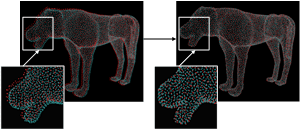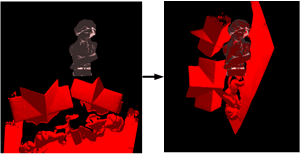|
|
|
|
|
|
|
 |
|
My research interests lie in the field of computer graphics. Currently, I am working on the following projects :
- OcTree-based topology repair and editing
- Geodesic computation on meshes: implementation and application
- Feature sensitive mesh processing
- Fast 3D registration in F.A. application
|
|
OcTree-based topology repair and editing |
|
Editing The Topology of 3D Models by Sketching
ACM SIGGRAPH 2007, to appear. (Paper, Movie)
Tao Ju, Qian-Yi Zhou and Shi-Min Hu
We present a method for modifying the topology of a 3D model
with user control. The heart of our method is a guided topology
editing algorithm. Given a source model and a user-provided target
shape, the algorithm modifies the source so that the resulting model
is topologically consistent with the target. Our algorithm permits
removing or adding various topological features (e.g., handles, cavities
and islands) in a common framework and ensures that each
topological change is made by minimal modification to the source
model. To create the target shape, we have also designed a convenient
2D sketching interface for drawing 3D line skeletons. As
demonstrated in a suite of examples, the use of sketching allows
more accurate removal of topological artifacts than previous methods,
and enables creative designs with specific topological goals.
Video: Download video here (31.8MB). (Cannot open the video? Cannot hear the audio? Get latest QuickTime player.)
Software: A software MendIT based on this paper will come soon, please refer to webpage: http://graphics.usc.edu/~qianyizh/software.html
Topology Repair of Solid Models Using Skeletons
IEEE Trans. Vis. Comput. Graph., Vol. 13, pp. 675-685, 2007. (Paper, Slides)
Qian-Yi Zhou, Tao Ju and Shi-Min Hu
We present a method for repairing topological errors on solid models in the form of small surface handles, which often arise
from surface reconstruction algorithms. We utilize a skeleton representation that offers a new mechanism for identifying and
measuring handles. Our method presents two unique advantages over previous approaches. First, handle removal is guaranteed
not to introduce invalid geometry or additional handles. Second, by using an adaptive grid structure, our method is capable of
processing huge models efficiently at high resolutions.
Slides: Download slides here (24.8MB). A poster for this paper is also available, download poster here (7.5MB).
Software: A software TopoMender based on this paper is now available, please refer to webpage:
http://graphics.usc.edu/~qianyizh/software.html
|
|
Geodesic computation on meshes: implementation and application |
|
Handling Degenerate Cases in Exact Geodesic Computation on Triangle Meshes
Computer Graphics International, 2007, to appear. (Paper)
Yong-Jin Liu, Qian-Yi Zhou and Shi-Min Hu
The computation of exact geodesics on triangle meshes is a widely used operation in computer-aided
design and computer graphics. Practical algorithms for
computing such exact geodesics have been recently proposed by Surazhsky et al (2005). By applying these geometric algorithms to real-world data, degenerate cases
frequently appear. In this paper we classify and enumerate all the degenerate cases in a systematic way. Based on
the classification, we present solutions to handle all the
degenerate cases consistently and correctly. The common
users may find the present techniques useful when they
implement a robust code of computing exact geodesic
paths on meshes.
|
|
Feature sensitive mesh processing |
|
Robust Feature Classification and Editing
IEEE Trans. Vis. Comput. Graph., Vol. 13, pp. 34-45, 2007. (Paper)
Yu-Kun Lai, Qian-Yi Zhou, Shi-Min Hu, Johannes Wallner and Helmut Pottmann
Sharp edges, ridges, valleys and prongs are
critical for the appearance and an accurate representation
of a 3D model. In this paper, we propose a novel approach
that deals with the global shape of features in a robust
way. Based on a remeshing algorithm which delivers
an isotropic mesh in a feature sensitive metric, features
are recognized on multiple scales via integral invariants
of local neighborhoods. Morphological and smoothing
operations are then used for feature region extraction and
classification into basic types such as ridges, valleys and
prongs. The resulting representation of feature regions is
further used for feature-specific editing operations.
Feature Sensitive Mesh Segmentation
ACM Symp. Solid and Physical Modeling, pp. 7-16, 2006. (Paper)
Yu-Kun Lai, Qian-Yi Zhou, Shi-Min Hu and Ralph R. Martin
Segmenting meshes into natural regions is useful for model understanding
and many practical applications. In this paper, we present
a novel, automatic algorithm for segmenting meshes into meaningful
pieces. Our approach is a clustering-based top-down hierarchical
segmentation algorithm. We extend recent work on feature sensitive
isotropic remeshing to generate a mesh hierarchy especially
suitable for segmentation of large models with regions at multiple
scales. Using integral invariants for estimation of local characteristics,
our method is robust and efficient. Moreover, statistical quantities
can be incorporated, allowing our approach to segment regions
with different geometric characteristics or textures.
Feature Sensitive Mesh Editing (Simplified Chinese version)
B.E. Thesis (Simplified Chinese version)
Qian-Yi Zhou
Thanks to the development of 3D range scanning and related techniques, triangular mesh models have recently emerged as a popular type of digital medium. Digital Geometry Processing based on triangular mesh models has achieved great progress. Features - Sharp edges, corners, ridges, valleys and prongs - have become crucial part in both research and application of mesh. In this thesis, we introduce a feature sensitive framework for mesh processing, including its theoretical basis and practical problems. As examples, we demonstrate the benefits of feature sensitivity for parameterization, geometry image, surface fitting and remeshing. Further more, we use our framework to solve some model comprehension problems, such as feature extraction, feature editing and segmentation.
|
|
Fast 3D registration in F.A. application |
|
One important category of applications in Factory Automation require the recovery of a module's position and pose from a scanned range image. See the above figure for an illustration: on a pipeline lies several modules of certain shapes, to automatically process each module, the machine must be able recognize the position and pose of each module. To this end a scanner is set above the pipeline to capture range images, and our task is to design the algorithm for the pose / position recovery, which is very similar to a 3D registration problem of partly-overlapped surface models. So we try to develop a registration algorithm to achieve the match between a single model and a large scene.
These projects are under the support of Omron Corporation. Some data and research results can not be published.
|
Registration project #1 (Finished)
Yong-Liang Yang, Qian-Yi Zhou and Shi-Min Hu
In this project, we study a fast local registration algorithm based on the second order Tylor approximation by the support of Kinematics theory. We use PCA to achieve global registration, which serves as the input for the local registration algorithm, and a uniform (isotropic) sampling is introduced to further improve the performance.
|
|
 |
|
Registration project #2 (Finished)
Yong-Liang Yang, Qi-Xing Huang, Qian-Yi Zhou and Shi-Min Hu
We use integral invariants to analyze features on a point cloud model. By calculating similarity between features, we perform a global registration and achieve the patch-to-whole-model registration purpose.
|
|

|
|
Registration project #3 (Proceeding)
Qian-Yi Zhou, Yong-Liang Yang, Yu-Kun Lai and Shi-Min Hu
In this project, we try to improve the performance of the previous project and do some experiments on scanned data from real scenes. Instead of calculating integral invariants, we develop an algorithm to calculate differential invariants on point cloud, which is as robust as integral invariants but much easier to compute. Further more, experiments are done on scanned data, especially for object-to-scene registration.
|
|

|
|
Tsinghua Statue Model
Qian-Yi Zhou
A goddess statue is the by-product of the 3rd registration project. The model is made up of
8 pieces of point cloud (30~80K points each), reconstructed, and hole-filled by using PolyMender
software.
Download (PLY file, 849,584 Triangles)
|
|

|
|
|
|
| Last updated
2006.9.13 |
|
